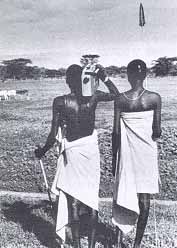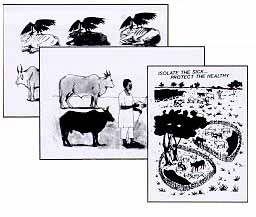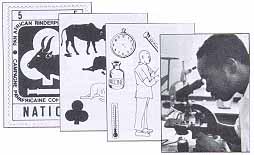 |  |
Address as many target audiences through as many media as possible - and people's awareness of PARC will become dynamic. What does this mean?
Different target audiences are in contact with each other. They are in contact for many reasons - family, business, work, politics, education, administration and so forth.
Campaign communication tries to take advantage of these contacts by informing many different groups. These groups, in turn, inform each other.
For example, if you inform school teachers about PARC (and provide them with teaching materials such as a PARC literacy booklet) � what may result?
School teachers influence community leaders, who in turn influence cattleowners. (These community leaders can also influence decision-makers about the importance of the Campaign.)
School teachers, of course, influence students who, in turn, describe the importance of the Campaign to their parents. Who are their parents? Cattleowners, community leaders, and perhaps even your own veterinary staff.
By using a multi-media strategy, you send PARC messages to target audiences from more than one direction.
For example, a farmer might learn about PARC from:1) a radio programme
2) a poster end leaflet
3) an adult literacy booklet or education programme
4) a son or daughter who learned about PARC at school
5) a PARC demonstration day organized at the local market
6) an agricultural extension worker
7) a community leader
8) a relative or friend
9) veterinary field staff or vaccination team.
In this example, the farmer will know something about PARC by the time the vaccination team (No. 9) arrives in his area.
Probably many of his doubts and questions about the Campaign have already been answered.
Pave the way for Campaign fieldworkers � use a multi-media strategy.In your country, many different groups are in contact. Campaign Communication informs them about PARC. Each group informs other groups. The effect is multiple. Awareness spreads in a dynamic way. |
Radio broadcasting can be very effective for generating dynamic | awareness of PARC among many people. But to succeed, the full potential of radio must be used.
If you talk as a veterinarian to other veterinarians, expressing PARC goals in the technical language of your profession, your messages will be interesting to your own professional group (the veterinary services) but may be less interesting to others. Present messages in ways that are relevant to other audiences.
Invite other groups to speak on the radio about PARC and related subjects. The appeal is much greater. For example, if policy-makers, are invited to speak about PARC and related topics, other policy-makers will be motivated to listen. Also community leaders, schoolteachers, students, and other social groups in the general public might be more interested. The effect can be multiple.
Ask your national radio producers about the types of programmes they can create in order to involve different groups. Use their creativity and expertise and you'll discover that radio programmes can help you manage the campaign.
A radio message......for the few"The new epidemiological data survey, utilising the ELISA, on herds in the northern province for last year shows sero-immune levels to be dangerously low. We plan to vaccinate those herds as a first priority of the prophylactic programme. " Appeals to veterinarians. ...or for the many?"Cattle owners in the northern province have good reason to be worried about rinderpest. We've just tested the cattle there. It was alarming to find that most could catch rinderpest and die at any time. Those cattle need protection. We're sending the vaccination team north right away." Appeals to cattle-owners, veterinarians, leaders and the general public. |
As the Campaign progresses, it begins to affect more people. Their attitudes, concerns and interests will develop. Different areas of the country may develop different ideas on livestock issues.
Radio programmes which help them to voice their thoughts will also inform you. For example, radio can let you hear what a community leader�five hundred kilometers to the south�says about a controlled grazing scheme.
Radio can let you hear a border official�far to the east�describe how nomadic herdsman are reacting to inspection of their cattle for rinderpest immunization. There are many such examples, involving many groups and geographical regions.
This knowledge is an invaluable tool for managing the Campaign. It helps you devise ways of overcoming obstacles and make the Campaign more acceptable to all concerned.
Creating a flow of information through radio programmes takes time and effort. The radio programmes must be well produced. Invite national radio producers to carry out a wide-ranging production plan Make your first effort with the cattleowners themselves, particularly rural people and migratory herdsman.
When more groups talk on the radio, more listen to the radio.

* Even if you are not concerned with nomadic or semi-nomadic people, this section applies to other important rural groups. Substitute the words "rural people" for "nomads" and "migratory people".

Does your veterinary service have a strong and positive relationship with migratory cattleowners? Semi-nomadic or nomadic herdsman might be your most important target audience. Their livestock can carry cattle disease such as rinderpest across national borders.
Establishing a good relationship with migratory cattleowners is not easy. But one way of beginning is both to inform migratory people about PARC and to learn more about their attitudes and concerns. How can you do this?
Person-to-person contact is obviously the best method for communicating with migratory cattleowners. Radio broadcasting is a very good tool to help pave the way for this personal contact.
Many migratory people listen to the radio. Radio reaches great distances and is their link to the outside world. But if you broadcast messages about PARC, will the herders listen?
Radio listeners in general (including nomadic people) often do not pay serious attention to propaganda, lectures or commands which come over the radio. You need something more attractive.
Nomadic Radio is radio programming which is specially designed to gain the attention and involvement of migratory cattleowners. Producing these participatory radio programmes can increase the knowledge about migratory cattleowners among veterinary staff, and vice-versa.
"erisio enkiteng' nabo elukunya o'lee"
"One cow is as good as a man"
(if a person cares for his cattle, he and the community will prosper)
Persistent Pastoralists: Nomadic Societies in Transition. by Peter Rigby. 1985.
Language: It is vital that Nomadic Radio programmes be made in the language understood by the cattleowners. At the same time, you will want your veterinary staff to understand many of the programmes too. The radio producers may have to translate programmes into one or more languages.
Production: An experienced local radio producer who can speak the nomadic language and become acquainted with their culture, should make the Nomadic Radio programmes. If there is no such radio producer available, make arrangements to have one trained. This can be done by your national radio service or possibly through a request for technical assistance to the PARC Coordination Unit Regional Office.
The Nomadic Radio producer(s) will require extensive field work to become acquainted with migratory people as they roam, gain their confidence, and record them on tape. The main programme content should not be recorded in the radio studio - it should come from the migratory people themselves - out in the field. This raw material then reeds to be edited into programmes back at the radio studio. Here the material can be checked for content too.
Broadcasting: Broadcast Nomadic Radio programmes on a consistent schedule when migratory people are likely to listen. Each programme can be repeated several times a week, and even reused in the future. Utilize all available radio transmitters.
Programmes for Nomadic Radio broadcastsRadio programmes for nomadic audiences should not concentrate exclusively on PARC. They should focus on topics interesting to migratory listeners and include PARC themes. Feature migratory cattleowners who are sympathetic with PARC procedures (including ear-punching, serum collection and reporting). Migratory cattleowners talking (in their own, everyday language) about a variety of non political subjects such as: 
Veterinarians talking about:
Anthropologists, community leaders, teachers describing
Broadcasters, journalists and other contributors presenting:
|
What should you show on a poster? What topics should be discussed on radio? The most obvious PARC messages are why, what, who, how, when, and where.
Determine which messages have highest priority, using your general experience.
How do you present these messages? This requires consideration and field-testing of ideas with cattleowners.
PARC may require cattleowners to cooperate with the veterinary service in ways that are new.
Hold informal discussions with community leaders and cattleowners about the Campaign before it begins to gain insight about potential problem areas. This will help you decide upon what your main messages should be and how to present them.
After you have produced some media materials for use with cattleowners (such as a flipchart, leaflet, poster or radio programme), field-test the materials with these and other audiences. You will find ways to improve the materials and help ensure that they will be useful and effective. Some field-testing guidelines are below.
Many ministries and organizations are in contact with cattleowners and their families, even though their work is not concerned specifically with livestock.
They may have a wealth of ideas and experience to share with you about communicating with rural people and other target audiences.
National experts include those in rural education, agricultural extension, religious groups, border control, law enforcement, rural radio, television, newspapers, family planning, rural health, the university (rural development and anthropology departments), livestock owner associations, trade unions, etc.
Consult national experts individually or call them together for a one-day workshop.
Let them help you to identify obstacles to the campaign, as well as to -define target audiences, media and messages. You may discover worthwhile techniques that will save you time, money and effort.
Consider PARC messages which have proved important in other countries. Some are shown on the art materials provided in this kit. The flipcharts, posters and leaflets are ideas for you to develop your own local messages, and draw pictures which are easily understandable by rural cattleowners. Do not print any flipcharts, posters, leaflets and adult literacy booklets until you have field-tested them with cattleowners and other target audiences.
Posters and leaflets1. Rinderpest kills � rinderpest is a cattle thief Healthy cattle with plenty of fodder and water available, can still be infected and die quickly from rinderpest. 2. Vaccinate! Vaccination can protect cattle against rinderpest. A wise cattleowner allows the veterinary services to carry out all immunization procedures. 3. Report! Cattleowners and local authorities must know the symptoms of rinderpest and report suspected outbreaks quickly to the veterinary services. 4. A sign of value Cattle with the cloverleaf earpunch are more valuable because they are protected against rinderpest. The earpunch is recognized by the veterinary services, government authorities, law enforcement agencies, cattle merchants. It is also recognized in bordering countries as the insignia of the PARC immunization programme. 5. Fewer, but better, cattle Introduces an important PARC theme - that when cattle are protected against disease (such as rinderpest) herds can be smaller because they are at less risk. if the smaller herd contains higher-quality cattle, it will be more productive. Fewer cattle will reduce the threat of overgrazing and land degradation. A selection of items in the PARC kit  Flipcharts1. The relunctant cattleowner The disaster that can befall the cattleowner who does not allow his cattle to be vaccinated 2. The wise cattleowner in contrast to the reluctant cattleowner, the wise cattleowner benefits from cooperating with veterinarians. 3. Isolate sick animals Cattleowners should be shown the benefit of isolating sick animals from healthy ones. A good subject for a flipchart to inform cattleowners. Various themes in the PARC kit.  |
Other messagesThe veterinary services unique objective As far as cattle owners are concerned, the veterinary service is interested in improving livestock production, and nothing else. Temporary restrictions Inform cattleowners when it is necessary to close cattle markets and to restrict the movement of cattle due to suspected outbreaks. Tell them why the restrictions are being made and that they will be lifted as soon as possible. Importance of cattle for food supplies, agriculture, employment and the economy The 'livestock factor' is often not given adequate importance by national planners. Yet cattle may figure prominently in the economy, food production, etc. If rural people lose their cattle through disease they may migrate to cities in search of employment. PARC is international Beyond your country's borders, other countries are also carrying out the same PARC immunization programme. Migratory cattleowners and merchants will encounter PARC wherever they go. The cloverleaf earpunch is a recognised sign of protection. Rinderpest struck recently Historical accounts of the devastation caused by rinderpest in the recent past � in your country or elsewhere in Africa. The tragic results for cattleowners. |
Other art material1. PARC postage stamp Artwork is provided for adaptation by government stamp printers for a national issue of PA RC postage stamps. 2. and 3. Basic art sheets These can be used for creating ideas for graphic materials, or even the materials themselves if no artist is immediately available. 4. Photos Make more b/w prints to have on hand for distribution to journalists. Or even better, create your own photofile of local subjects.  |
Using the PARC stickerThe PARC stickers are designed to identify PARC vehicles, equipment, property and correspondence. Three sizes are available. The surfaces on which the stickers are to be applied must be thoroughly clean, dry and fairly cool. The stripes should be applied diagonally, with the gold stripe uppermost. Apply the logo sticker squarely over the stripes.  |